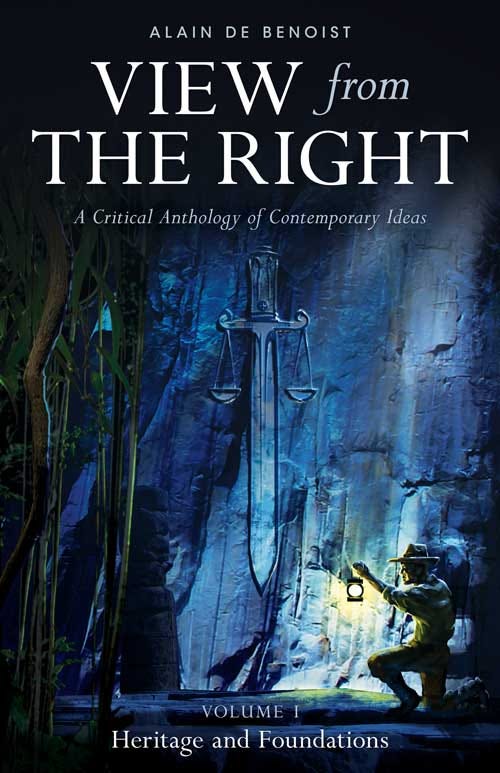The Roots of Civilisation
by Alain de Benoist
Alain de Benoist draws attention to the depth and continuity of civilisation in Europe, presenting the groundbreaking discoveries of Alexander Marshack to trace the heritage of European art back to the Stone Age and highlight the prehistoric roots of European consciousness’s creative engagement with symbols, time, and narrative.
The Great Cultural Revolution
The great cultural revolution took place here [in Europe] 35,000 years ago—if not earlier.
“It seems,” writes Professor Alexander Marshack, “that in an age as remote as 30,000 years before our era, during the glacial period, the western European hunter had made use of a previously evolved, complex system of notation whose tradition might go back many thousands of years. This notation proceeded from a cognitive technique that was time-factored and time-factoring.”
It is probably one of the most important discoveries of the century in matters concerning prehistory.
Everything began in the early 1960s. Marshack, solid, jovial, short-haired, and a researcher at the Peabody Museum of Ethnology and Archaeology at Harvard University, investigated the problem of “origins.” His aim: to determine the nature of mental processes among the earliest humans.
“Within the limits of the evolution of the species,” he observed, “the brain has remained a constant for one to two hundred thousand years.”
There is thus no “progress of humanity,” but rather a continued transformation of the world by a humanity whose brain has remained the same since the remotest of times. If the human phenomenon forms a whole, then “culture” is equally ancient.
Marshack hypothesized:
“Pre-historical man, man of the glacial period, did not differ greatly from contemporary man. What differs most are the facts, the ideas, and the relations inculcated in his brain—but not his manner of functioning, his aptitudes, his capacities, or his intelligence.”
In other words, Homo sapiens was not simply a maker of tools; he was also capable of recognizing and employing forms. He was conscious of notions of consequence, of symbol, and of time. Marshack called this activity time-factored.
Deciphering the Bones
Marshack set out to prove his hypothesis. He began deciphering engraved bones.
Lunar “Phrases”
Until then, prehistorians who discovered signs on bones or stones dismissed them as “decorative motifs” or “hunting marks.” Marshack looked closer.
Between 1965 and 1970, he studied more than a thousand prehistoric objects from nine European countries, subjecting them to microscopic and photographic analysis. The results surpassed expectations.
He found that the notches, points, and striations were not random. They had been carved at different times, from different angles, with different tools. Many objects contained groups of 29 or 30 marks, aligning with the lunar cycle. Subgroups within these sequences corresponded precisely to the phases of the moon.
Marshack described this as “an almost perfect lunar phrasing right down to its subdivisions.”
Examples included:
La Marche bone (221 marks ≈ seven lunar months)
Abri-Blanchard bone (double line of 69 rounded wells, tool-tip changed 24 times)
Barma Grande pebble, among others
The Great Hunters and Their Rituals
These discoveries revealed that prehistoric man possessed a visual memory aid—a system of notation common to the Upper Paleolithic across Europe, more advanced than some historical systems.
Marshack also linked this notation to rock engravings of animals, female figures, and vulvic symbols, arguing that they too were time-factored, forming part of a dramatic-narrative ritual system.
Henri de Saint-Blanquat noted:
“One of the horses visible on the bone of La Marche possesses three ears and three eyes, two manes, and two back lines… Everything suggests that the horse had been ‘used’ many times, each ‘use’ corresponding to the addition of organs to the carving.”
Thus, lunar cycles and seasonal myths may have been embedded in symbolic narratives. Marshack concluded:
“The vulva itself is to a certain degree a ‘non-sexual’ symbol… representing the stories of processes that include birth and death, menstruation, and the time-factored cycles of nature.”
How far back does this system go? The Pech-de-Lazé bone (–230,000 years), discovered by François Bordes, opens breathtaking possibilities.
From Pre-Writing to Proto-Modern Man
For Marshack, these engravings represented the roots of science and writing: a pre-writing, a pre-numeric notation, the substructure upon which later writing and mathematics were built.
This radically changes our view of early humans. The “primitive” hominid fades, replaced by a proto-modern human—a being with practical knowledge of time, place, and territory, and the ability to describe and symbolize experience.
The “human fact,” Marshack argued, is defined not merely by toolmaking, but by an awareness of time, narrative, and consciousness itself:
Man is the animal who is conscious of having consciousness.
Reception and Controversy
Marshack’s book Les Racines de la civilisation (Plon, 1972; English: The Roots of Civilisation, McGraw Hill, 1972) caused a sensation. Major outlets like The New York Post, The Washington Post, Mosaic, Antiquity, The Boston Globe, and Newsweek covered it. Scholars including Lewis Mumford, Carleton Coon, Hallam L. Movius Jr., and Gerald S. Hawkins praised it as a revolutionary breakthrough.
In France, Marshack’s earlier Notations dans les gravures du paléolithique supérieur (1970) had gone largely unnoticed. But Racines gained serious attention, sparking debate in anthropology, archaeology, and even linguistics.
Marshack’s later articles—Cognitive Aspects of Upper Paleolithic Engraving (Current Anthropology, 1972), Upper Paleolithic Notation and Symbol (Science, 1972), and Exploring the Mind of Ice Age Man (National Geographic, 1975)—further developed his thesis.
His work aligned with a broader re-evaluation of European prehistory in the 1960s–70s, alongside Colin Renfrew on dating, Alexander Thom on prehistoric astronomy, and John Dayon on technology.
Conclusion
Marshack transformed the way we see Ice Age humanity. The Upper Paleolithic was not an age of “primitive savages,” but of humans already grasping symbol, time, and story—the first steps toward civilization.
From the notched bones of hunters to the megalithic alignments of Stonehenge, we glimpse the continuity of a time-factoring mind: the beginning of man’s dialogue with the cosmos.
The above text is an excerpt from Alain de Benoist’s View from the Right (Arktos, 2011). If you liked this selection, be sure to check out the whole book.





The real question here is how were we so naive to think otherwise for that long? And the following one: whose interest was behind this obvious dissimulation of our common history? Some people already in the nineteenth century were aware of the fact that our view of evolution was more a fable convenue than anything else. I let you imagine their fate…
Alain de Benoist has the biggest private library in France, so probably one of the biggest in the world too. Yet he is constantly ostracized by the mainstream media. How many brilliant spirits are currently in this situation? How long will this empire of lies and corruption last?
Was Rousseau and his noble savage theory more insightful than Voltaire on this point? I let you judge…
A refreshing blast of unvarnished truth. This piece rightly demolishes the liberal-modernist superstition that civilization is a sterile construct of laws and economics. It correctly identifies civilization as an organic outgrowth of a specific people—their unique spirit, blood, and religious genius. The obsession with “Values” over bloodline is the central error of our age, a root cause of our civilizational decay. A necessary corrective to the dead-end materialism of both the left and the faux-right.